1) Europe: The retiring type
VISUAL CAPITALIST: Visualizing the World’s Super-Aged Societies
Not even close: Europe, led by proto nursing-home-of-the-tax-evading-rich-Monaco, wins the race to super-aged-ness.
Outside of that you’ve got some island/mini states (most on the well-to-do, offshore banking side of the global ledger), plus a quartet from Asia (Japan, ROK, Taiwan, HK)
As for the Americas? More small islands (two being US territories) plus … wait for it … Canada!
For Canada, add this to the list of reasons why it will necessarily join up with some larger scheme/resource pool in the future.
Other than Canada and those islands, the Western Hemisphere is truly under-represented here, which is good.
The larger lesson? To develop economically is to age — to have processed your demographic dividend at some point in the past and hopefully gotten richer in the process.
2) Joined at the Himalayas
NYT: India and China Agree to Resume Direct Flights After Nearly Five Years
What caught my eye in the piece is the growing awareness regarding how each side needs the other:
India’s potential as an industrial power still remains largely unmet. Beyond some recent success stories in technology, such as the expansion in iPhone manufacturing in India or investments in future chip making, the country has struggled to significantly expand manufacturing.
Guess who is best positioned to fix that.
China watchers have pointed out that this is also an area where India’s aspirations remain vulnerable to China, the source for machinery and raw material of many of India’s industries.
India needs China to help it rise.
In its anxiety that India is being groomed as a kind of replacement, China has been restricting exports of some of that machinery to India.
Meanwhile, China fears India’s rise — a sort of All About Eve dread.
No one likes to be replaced by a younger, cheaper version of themselves — unless they’re your kids!
3) This shit’s about to get real
GUARDIAN: What would happen if the US military went after cartels on Mexican soil?
Turning the War on Drugs into a Global War on Terror-clone: one way to go.
Still, Colin Powell’s old bit about you break it, you own it … holds true. The drug industry in Mexico is a major employer — perhaps the nation’s largest.
The problem? Mexico’s drug cartels have a long demonstrated disregard for collateral damage, as nobody quite does ultra-violence like they do. Plus, most cartels are already well versed in the creation of snuff films that intimidate and terrorize the public (not unlike your worst radical Islamic terror groups).
The short-term fear? Cartels retaliate against US tourists and other soft US targets — something a hardcore Trump administration might actually welcome as precursor to a serious military incursion by our side. Recall the cross-border strike that convinced Wilson to launch a mini-invasion to capture Pancho Villa in 1916.
What did the Wizard of Oz say about uniting people?
The longer fear? We set in motion the rise of an ISIS-like terror entity like we did in Iraq by following the decapitation/assassination kill-list model that sees ever-more-radical leaders emerge and rise to the top over time.
Our record on creating terror-criminal groups is kind of amazing: al-Qaeda, ISIS, M13, various Mexican cartels, and now maybe some Mexican terrorist-to-be-named-later.
I guess we’ll have to try all the old tricks before finally coming to our senses and developing some new ones.
Sometimes you do just have to lose to win. I suspect Trump 2.0 will teach us that in spades.
4) China’s confidence in the face of a trade war with Trump
ASIA TIMES: China continues to shift exports to Global South
It’s as simple as this:
Exports to the US now comprise just 15% of China’s total shipments, down from 20% in 2018
This is all part of China’s concerted push to make itself the most important economic partner of the Global South — otherwise known as the primary source of economic growth and consumer growth this century.
The main driver of Chinese exports remains the Global South, especially to countries where China is building infrastructure.
A package deal known as the Belt and Road Initiative.
With a trade surplus last year of just around $1T, China can withstand any threat to that 15 percent, because the Global South is already the biggest collective export market for China, surpassing the advanced economies.
The judgment:
Washington’s ability to pressure China through tariffs or other import restrictions has diminished as the center of gravity of China’s trade shifted to the Global South.
The telling example — from SE Asia, of course, currently enjoying its demographic dividend:
Indonesia is a standout in China’s export profile. Its purchases from China have tripled during the past four years to $9 billion a month, or an annual rate of $108 billion.
The Carnegie Endowment wrote in December 2023, “Over the past decade, China has made massive investments in Indonesia through Belt and Road, spanning various sectors such as infrastructure and mining. The BRI framework has solidified China’s position as one of Indonesia’s largest trading partners…. Chinese investments have the potential to bolster Indonesia’s economic growth, particularly when directed toward infrastructure development.”
When trade experts speak of Trump’s tariffs driving trade partners into the arms of the Chinese, this is what they’re talking about.
5) Why I’m glad I stuck with “demographic collapse” in the subtitle
MCKINSEY GLOBAL INSTITUTE: Dependency and depopulation? Confronting the consequences of a new demographic reality
When it came to titling the book (America’s New Map: Restoring Our Global Leadership in an Era of Climate Change and Demographic Collapse), I, for a long time, felt that last word was too much. I am glad I went with BenBella’s suggestion.
A new MGI report (always good) with these summary insights:
Falling fertility rates are propelling major economies toward population collapse in this century. Two-thirds of humanity lives in countries with fertility below the replacement rate of 2.1 children per family. By 2100, populations in some major economies will fall by 20 to 50 percent, based on UN projections.
Age structures are inverting—from pyramids to obelisks—as the number of older people grows and the number of younger people shrinks. The first wave of this demographic shift is hitting advanced economies and China, where the share of people of working age will fall to 59 percent in 2050, from 67 percent today. Later waves will engulf younger regions within one or two generations. Sub-Saharan Africa is the only exception.
Consumers and workers will be older and increasingly in the developing world. Seniors will account for one-quarter of global consumption by 2050, double their share in 1997. Developing countries will provide a growing share of global labor supply and of consumption, making their productivity and prosperity vital for global growth.
The current calculus of economies cannot support existing income and retirement norms—something must give. In first wave countries across advanced economies and China, GDP per capita growth could slow by 0.4 percent annually on average from 2023 to 2050, and up to 0.8 percent in some countries, unless productivity growth increases by two to four times or people work one to five hours more per week. Retirement systems might need to channel as much as 50 percent of labor income to fund a 1.5-time increase in the gap between the aggregate consumption and income of seniors. Later wave countries, take note.
In confronting the consequences of demographic change, societies enter uncharted waters. Absent action, younger people will inherit lower economic growth and shoulder the cost of more retirees, while the traditional flow of wealth between generations erodes. Long-standing work practices and the social contract must change. More fundamentally, countries will need to raise fertility rates to avert depopulation—a societal shift without precedent in modern history.
I love the obelisk bit. I independently came up with the very same image/term in my second MOOC (Massive Online Open Course) on edX and Coursera:
My full-up sequence is thus: PYRAMID to OBELISK to DIAMOND to BULB to (SPINNING) TOP:
Pyramid is the starting point (and norm for most of history), as in, bottom heavy with kids and/or liftoff for a Baby Boom
Obelisk is the Youth Bulge working its way “up” in age
Diamond is the Demographic Dividend
Bulb is the Super-Aging effect that follows the completion of the dividend
Spinning Top is when you’re truly swamped by the Silver Tsunami.
Great minds, huh?
As always, an excellent bit of broad-framing analysis from MGI.
6) Don’t believe Trump or fossil fuel industry on “higher cost” RE
YAHOO: New study sheds light on common myths about solar and wind power's effects on electricity: 'Knowledge is power'
ELSEVIER: No blackouts or cost increases due to 100 % clean, renewable electricity powering California for parts of 98 days
The judgment per Yahoo:
A study shows that claims about renewable energy's [RE] high cost are demonstrably false.
From the study itself (abstract):
Critics of a global transition to clean, renewable electricity argue no wind- or solar-dominated grids exist and solar and wind’s variabilities cause blackouts. This paper uses data from the world’s 5th-largest economy to show no blackouts occurred when wind-water-solar electricity supply exceeded 100 % of demand on California’s main grid for a record 98 of 116 days from late winter to early summer, 2024, for an average (maximum) of 4.84 (10.1) hours/day. Compared with the same period in 2023, solar, wind, and battery outputs in 2024 increased 31 % 8 %, and 105 %, respectively, dropping fossil gas use by an estimated 40 %. Batteries, which shifted excess solar to night, supplied up to ~12 % of nighttime demand. Wind-water-solar is not the cause of high California electricity prices; to the contrary, most all states with higher shares of their demand met by wind-water-solar experience lower electricity prices. Thus, data support models: a reliable wind-water-solar-dominated large grid appears feasible.
Why this matters: the entire world is moving in this direction, so the earliest adopters offer the firmest proof to dismiss Trump’s false criticisms regarding both availability and price.
Such firm evidence matters in an America where, per Yahoo, “in 2023, 21.4% of U.S. energy demand was met with renewable resources” and “in the first three quarters of 2024, 90% of new electrical generating capacity came from renewables.”
The enduring throughline is this: RE is getting cheaper while the cost of using fossil fuels is only rising.
7) Non-government donors loom large in WHO funding
VISUAL CAPITALIST: Visualized: Who Funds the World Health Organization?
Trump just pulled America out of the WHO — again, and is already hinting about a return if a better deal might be reached. His primary beef? He says America donates $500M annually while China donates only $39M/year.
Weirdly enough for Trump, he gets the Chinese number correctly but not the US total ($1B).
But what really stuck out to me when I saw the chart was the #2 position held by the Gates Foundation — coming close to matching the entire US contribution.
Still, I get Trump’s point: the Rotary Club contributes 4X as much as China does, and, last time I checked, no pandemics have been caused by that totally admirable organization, which likewise has no plans to re-order the world system.
The US accounts for roughly one-quarter of global GDP, so a 15% share isn’t really a burden, one might argue. Or you can credit Bill and Melinda for covering the rest of the logical national burden.
Can anyone spot the mistake on the chart? The mis-identification?
8) Just a little of that human touch
WAPO: D.C. is America’s loneliest city. Can 1,000 robotic pets help?
Now we’re seeing some experimentation for emotional service:
Seniors living on their own are at higher risk of becoming depressed and inactive, having accidents and neglecting their health, research shows.They tend to be hospitalized more often and suffer earlier-than-expected deaths.
A 2022 study found that older adults who had owned a pet (living, not robotic) for more than five years showed slower decline in verbal memory — for example, being able to recall words — over time compared to non-pet owners.
So, why the robot versus the actual animal?
Vet bills, exercise demands and more can make living pets unfeasible for many.
The first experiments were in NYC, but have since expanded to DC because of the positive results.
The only trick? Dementia patients sometimes disable the robot by trying to actually feed it.
Still, this makes intrinsic sense to me. My wife, the hospice social worker, scours thrift stores for stuff animals and quilts that she donates on her own to her many clients, and she attests to the positive impact even just a stuffed animal can have — something I’ve personally witnessed with her almost 100yo mom now in memory care.
Why?
It’s the sheer loss of touching that is most debilitating to isolated seniors over time — the lack of pleasant and comforting physical contact.
My mom passed during COVID but not because of it, and yet, her last months were painfully isolating because of COVID. The last time I spent with her I was completely geared up, along with my spouse. I will never forget holding and stroking her hand.
9) Trump barking up wrong tree with Colombia threats
NYT: Trump’s Colombia Tariff Threat Targeted a Vibrant Alternative to China
With Trump slating Mexico and China for trade wars, a lot of that near-shoring investment has actually been targeting Colombia as a safe haven.
Trump’s recent tariff threats over deportation flows … not helpful.
This is a wonderful piece of reporting: worth a read to see how this one manufacturer has survived a stint in China, has recently moved some production to India, and was — until quite recently — very bullish on Colombia.
The lesson? With Trump backing off his threat following the Colombian president back off his own …
For the moment, commerce would presumably carry on unhindered. But the episode underscored the growing complexities of international trade as Mr. Trump wields the threat of tariffs as a primary instrument of policy.
Blunt stick, speaking loudly … not a great combination.
10) Greenland & climate change’s big flush
POPULAR SCIENCE: Greenland’s lakes are getting uglier—and fast
For just about … ever, Greenland’s many lakes have been crystal-clear carbon-sinks full of diverse life.
Then, one year, they weren’t any of those things — perhaps forever more.
A serious shocker to those scientists who track such things.
The before pic:
Like looking through glass.
The after pic:
Like somebody did a Boston Tea Party.
The change was unreal and apparently unfolded between 2022 and 2023.
Jasmine Saros has visited West Greenland every summer since 2011. Saros, a professor of lake ecology at the University of Maine, travels north annually to collect data on the region’s fresh waters. In 2022, she conducted her usual rounds of sampling and assessment on the 10 representative lakes that her and her colleagues routinely visit. Everything was generally as expected–slowly shifting in accordance with climate change, but outwardly appearing as it had for more than a decade. Then suddenly, it wasn’t.
The next year, summer 2023, Saros returned to find the familiar lakes utterly transformed. “You could see it right away,” she says. The water bodies had gone from crystal clear and blue–their rocky bottoms as visible as if looking through glass–to a steeped tea-brown. At first, the scientists thought perhaps it was just one lake, then two, then three. Until “every single lake we went to had changed in this way,” Saros says. “There was this major transformation that occurred across all the lakes in the landscape,” she tells Popular Science. “It was really astonishing.”
I would be unnerved too.
The details:
Among the changes: the lakes lost 90% of their microbial biodiversity, gained 1,000% more dissolved iron, and went from absorbing carbon dioxide to emitting it–shifting from sink to source, per the new research, led by Saros.
The culprit?
One warm, wet fall, in which atmospheric rivers (again with this term suddenly everywhere!) sequentially drenched West Greenland, essentially taking huge amounts of material (“think soil, decaying muck, and plant detritus infused into a broth”) and and flushing it all into these lakes, perhaps changing their makeup for good.
Why this is scary: climate scientists prefer to watch arctic lakes as canaries in the coal mine. They tend to change slowly and “truly” on their own because humanity is pretty much completely absent from the scene.
The ultimate diagnosis:
[Researchers] homed in on a two month period in the fall of 2022 when Greenland experienced record heat and rainfall, resulting from multiple back-to-back atmospheric rivers. During the heatwave and excess rains, lots of permafrost thawed, releasing a large volume of organic matter and metals bound in the soil. “This extreme autumn season essentially led to a big flushing of that material into lakes,” says Saros. Lakes expanded and became more connected to each other, intermixing and spreading the change far and wide. Additional heavy rains and heat in July 2023 added to the pile-on. Satellite imagery suggests the change wasn’t specific to the lakes. With the added heat and water, the land changed too, becoming measurably greener.
Greenland going back to actually being green, something that hasn’t really occurred for … say … 400,000 years, so … notable!
Scale and timing here matches that statement that you’ve heard from me in presentations about how scientists estimate that climate change is forcing all species to adapt at roughly 10,000 times normal recent speed.
Think about it: two months to transform Greenland into something it hasn’t experienced in 400 millennia.
That … is fast.
This is how humans trigger a mass extinction era.
So yeah, when you consider huge Greenland — roughly the geographic size of California but with a population of 57k versus 39m (think, tax base), it does seem implausible that Greenland-for-Greenlanders is going to work out well.
You want to talk inconceivable? Like only a single digit pool of Greenlanders saying they want to become Americans in a recent poll?
Greenlanders, largely on their own, managing this unreal transformation of their lands in an evolutionary blink of an eye … THAT is inconceivable.
World population density per square km is about 60.
Check out this chart on Wikipedia: Of the 248 entities listed, Greenland comes in dead last at one-fifth of one person per square km.
Canada is 237th at 4.1, while the US is 184th at 35 and Latin America as a whole is similar at 33.
These stats tell me two things:
The Western Hemisphere is relatively empty compared to the Eastern Hemisphere, which holds more than 4/5ths of the world’s population — so, good on us.
When climate change empties out the lower latitudes in the Americas because life there just becomes too hard/costly, those people are heading north to the Great Emptiness.
And that’s when things get interesting, eh?
11) Bringing You the End Times Since 1947
NYT: Doomsday Clock Moves One Second Closer to Catastrophe
The Doomsday Clock has always been a clever shtick but nothing more — just a gauge of collective fears among the scientific community.
For the longest time it was solely about nuclear Armageddon, and back then it was minutes away — 7 actually when the whole show was launched in 1947.
Problem was, the Cold War ended and nuclear arms stockpiles were radically reduced and by 1991, the whole scare-factor element was gone (we have 17 minutes to live!).
Ah, the threat of irrelevance …
Since then the Bulletin of the Atomic Scientists, responsible for setting the measure, has been piling on climate change — nowhere near the same range of a singular doomed day of nuclear exchanges worldwide, because we’re talking decades of unfolding (bit more time to adjust). Recently, they added killer robots/AI for good measure. So, we’re basically in the grab-bag mode since the Cold War’s end — a hearty broth of fears mixed together.
What does it prove? Nothing, really. It’s all symbolism: We are presently closer to doomsday than ever before!
Not true. Not even close.
12) The final-final Los Alamos National Lab report on the climate change symposium to which I presented/contributed
LANL: 2024 Los Alamos Symposia Series Executive Summary — Climate Security; Harnessing Transformational Technologies
As noted previously here (see below referenced post for some of the cool graphics), Throughline did the formatting and graphics on this truly beautiful report.
My slide deck from that presentation can be found here:
Here’s the actual finalized report:





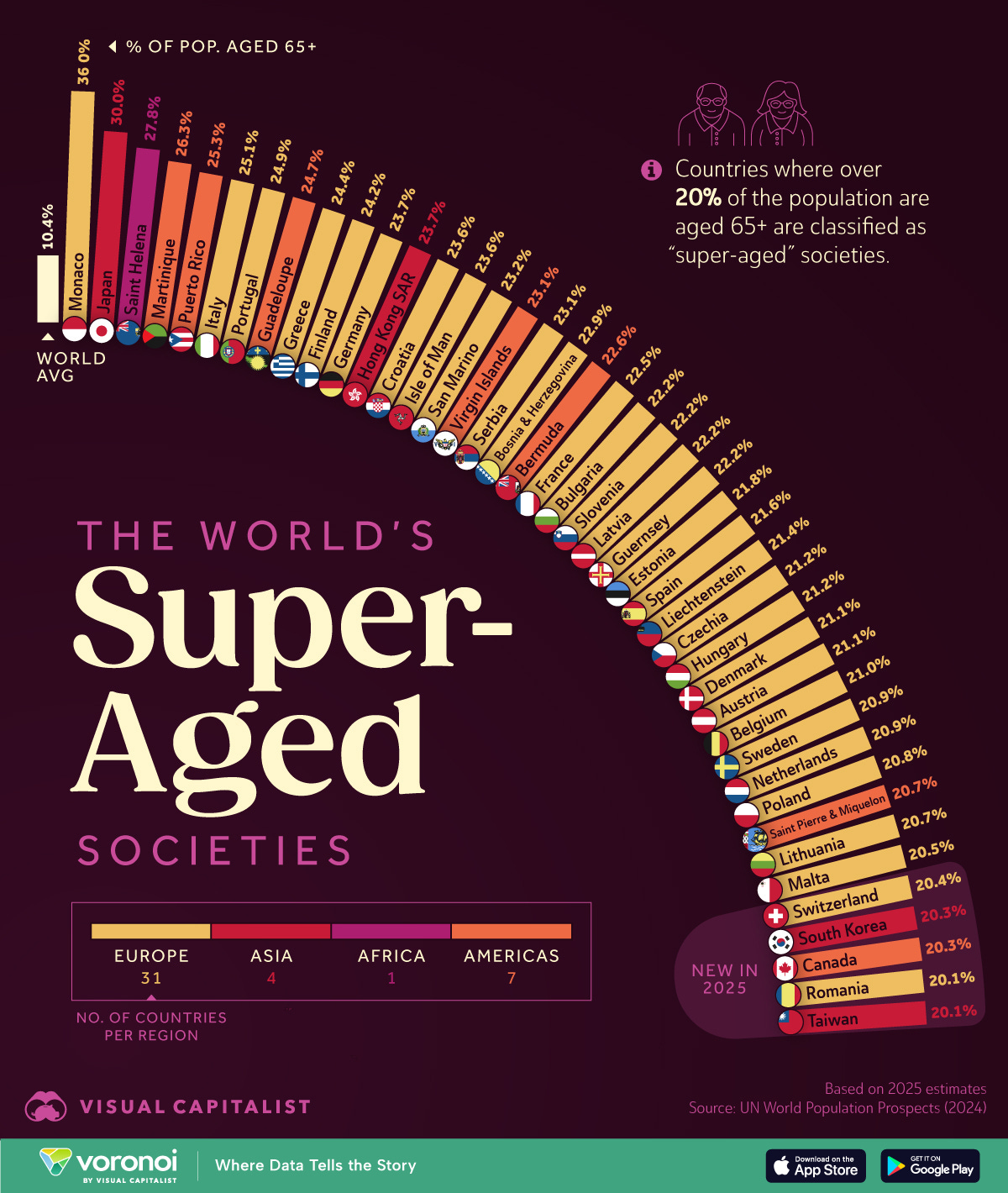
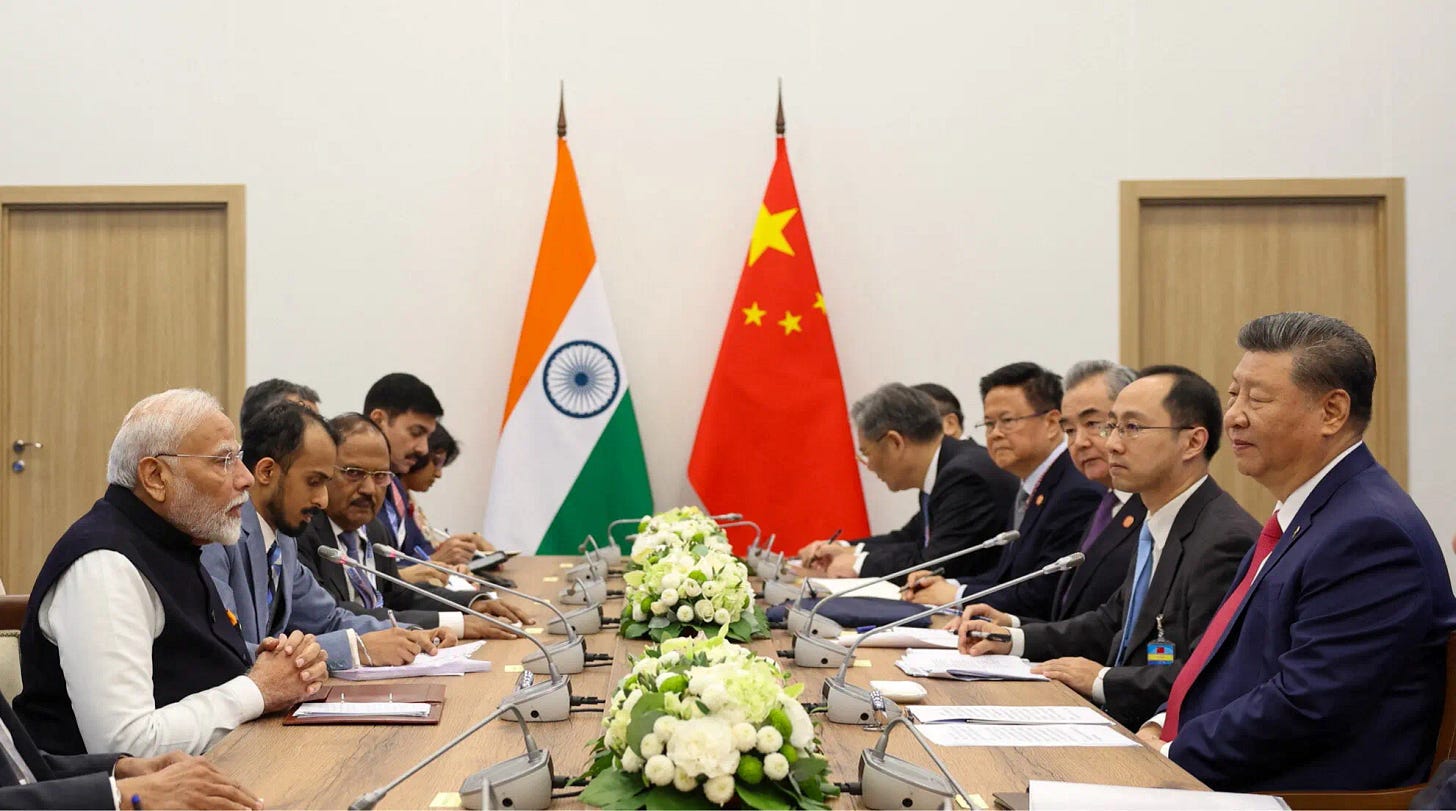




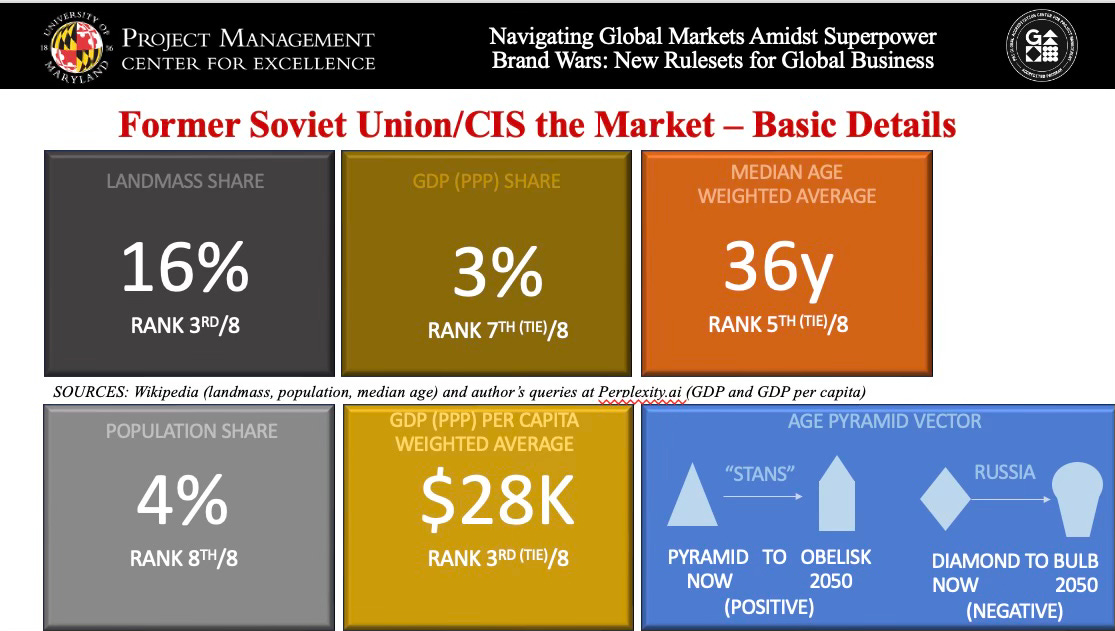



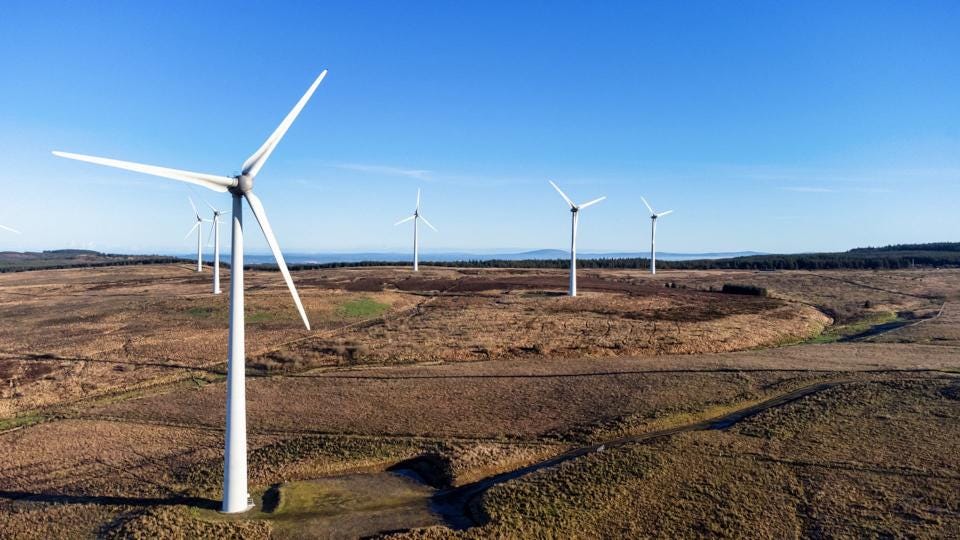
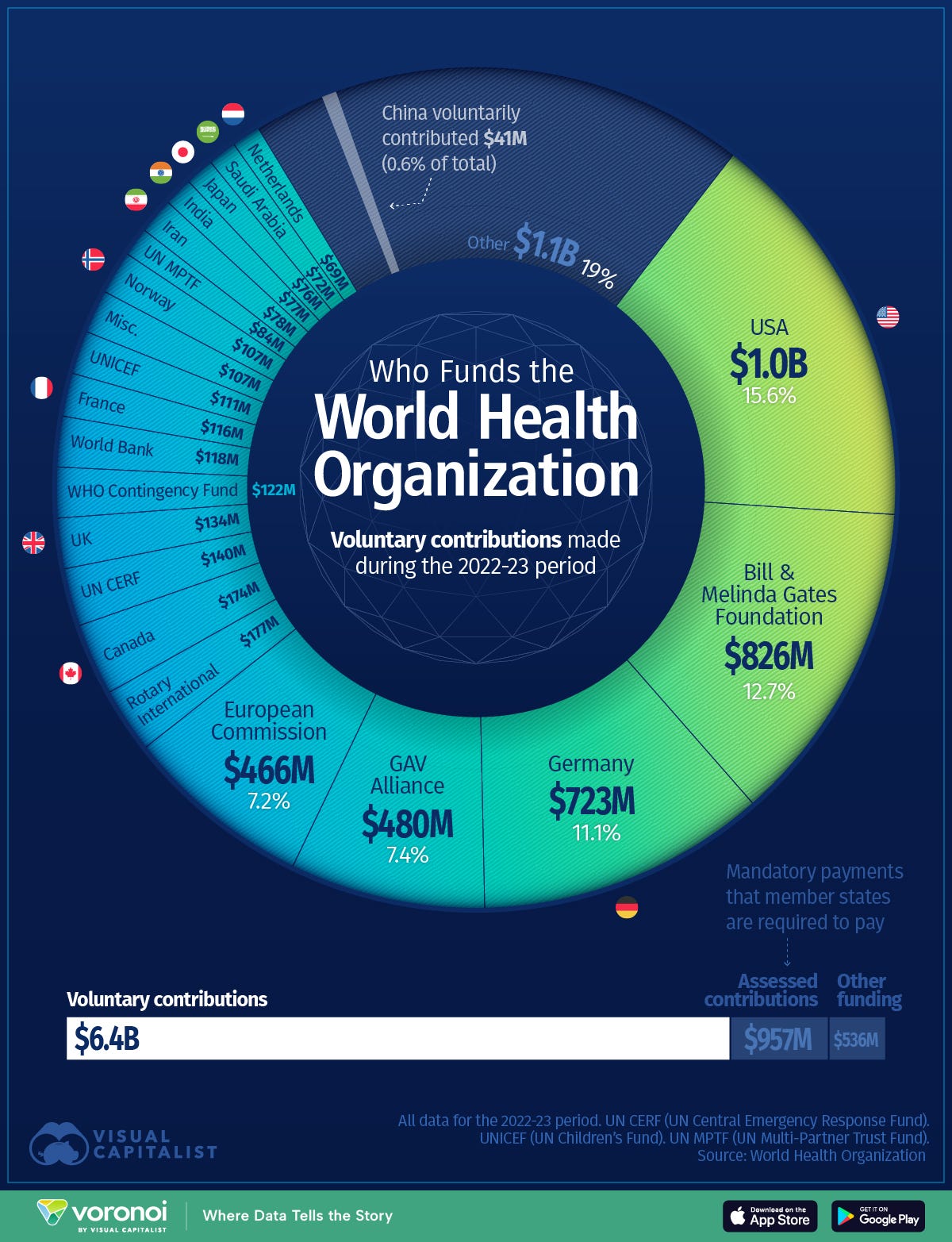


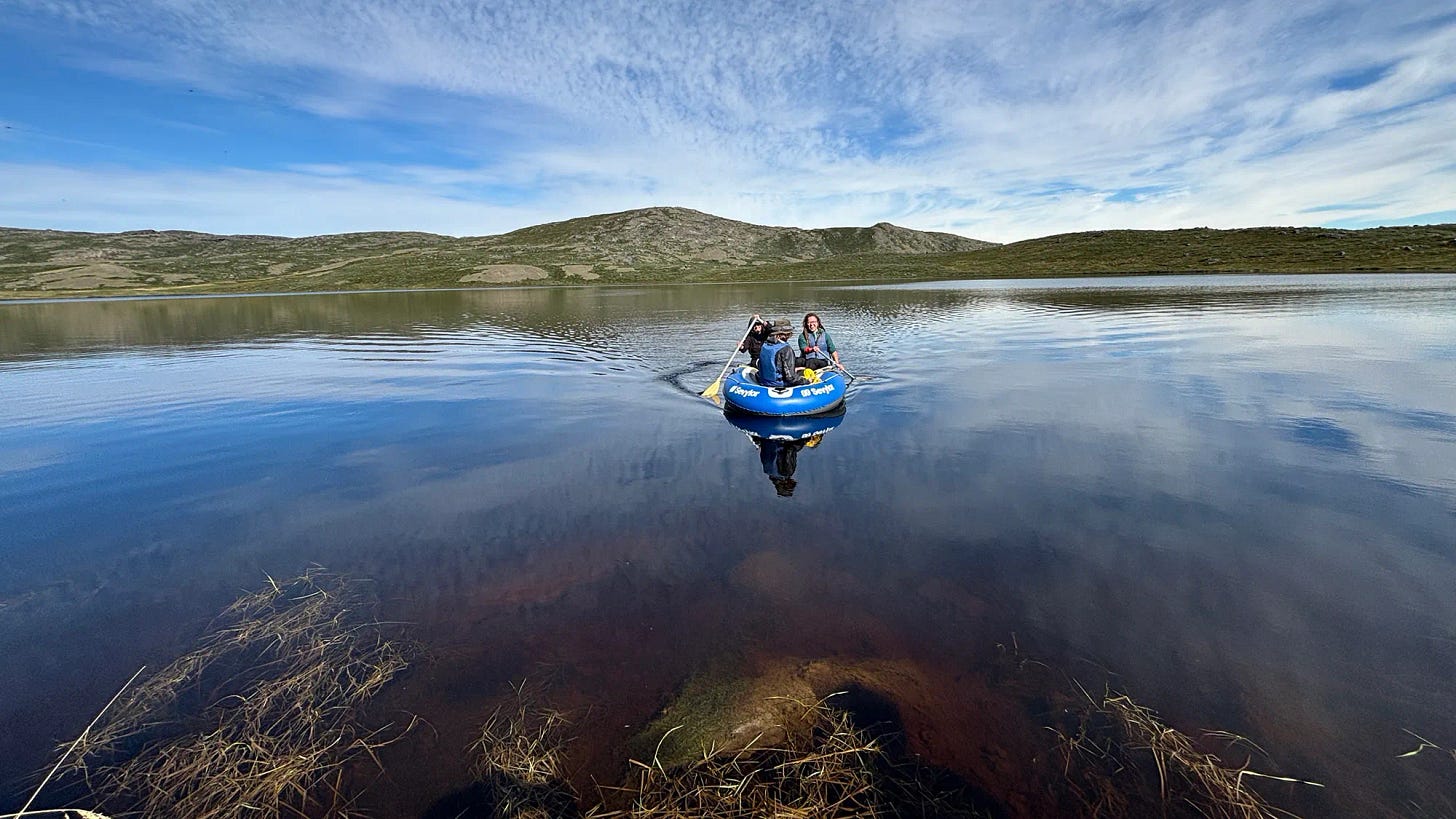


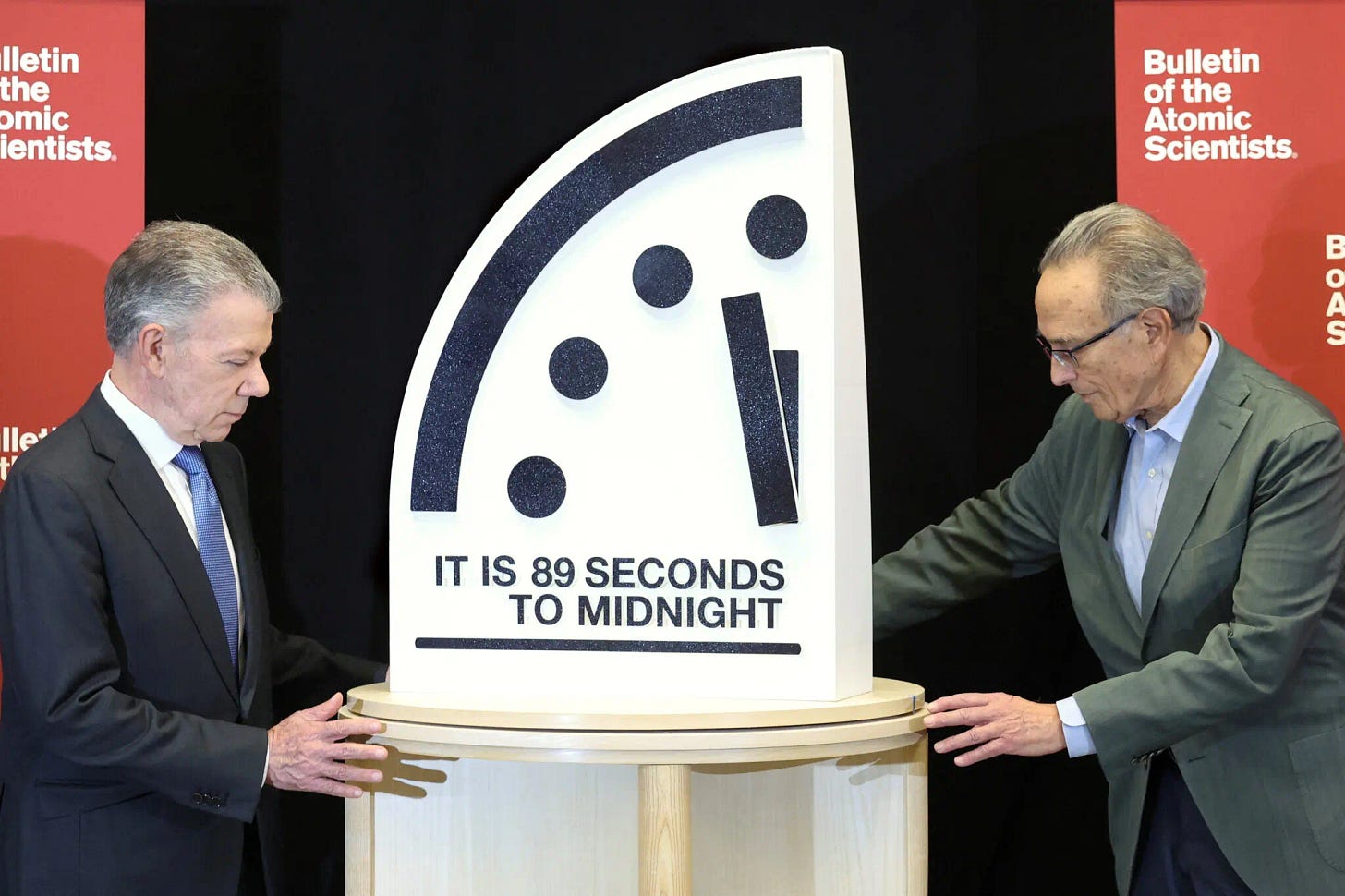

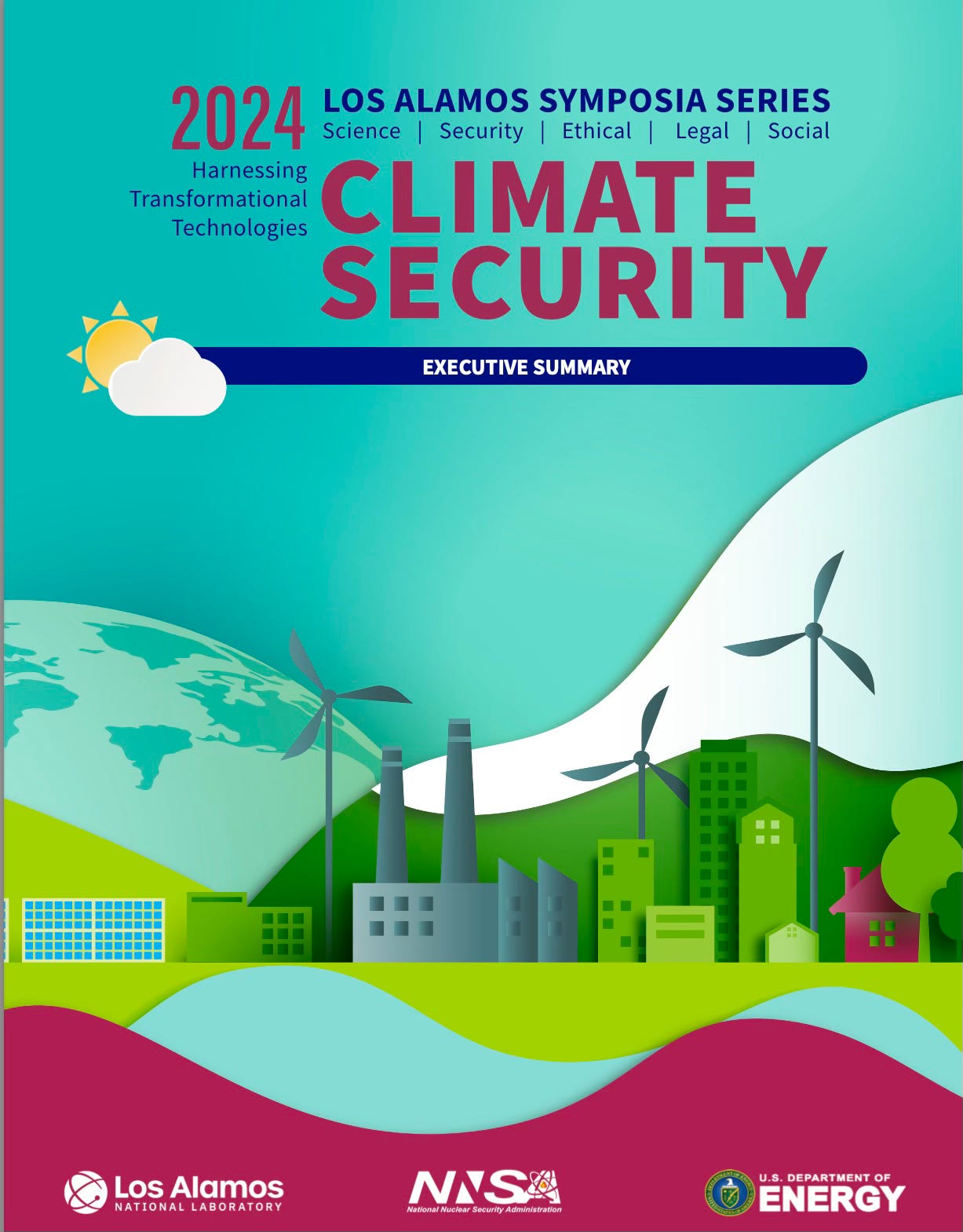




GAVI, not GAV
I give up! What's the mistake on the WHO chart?